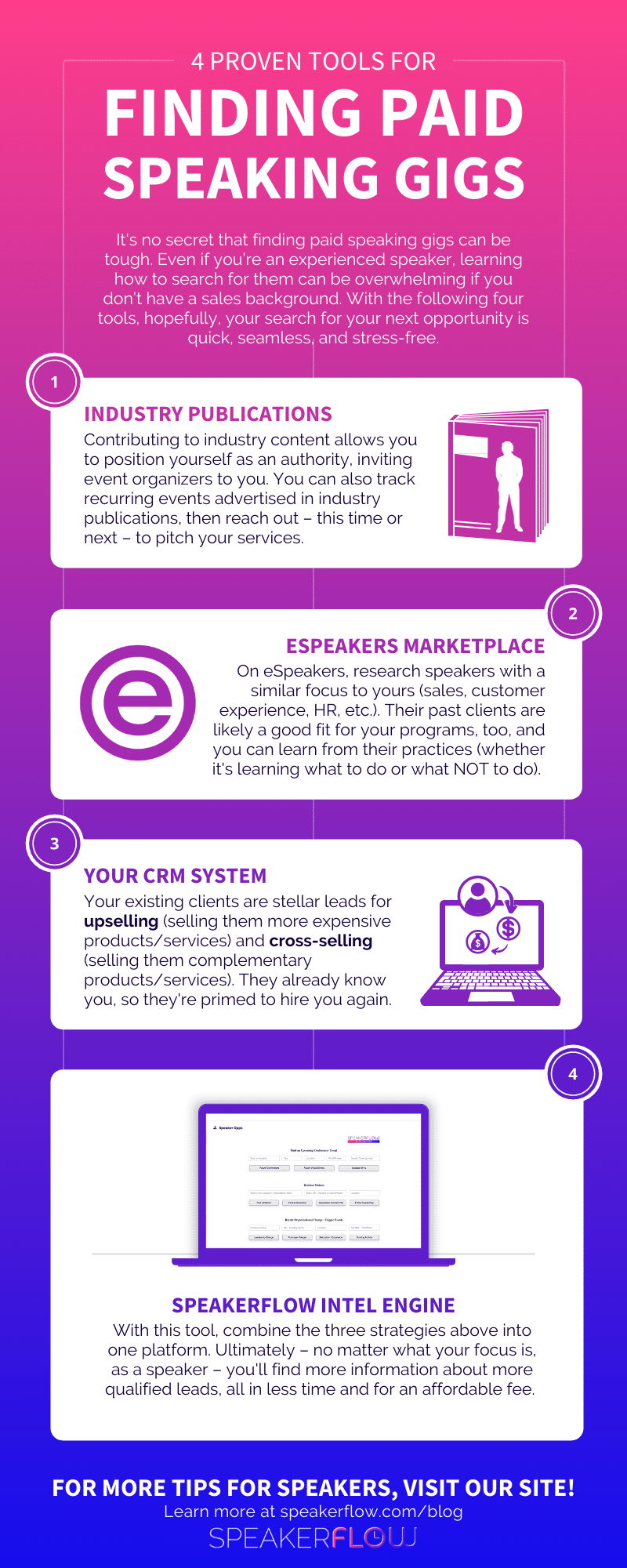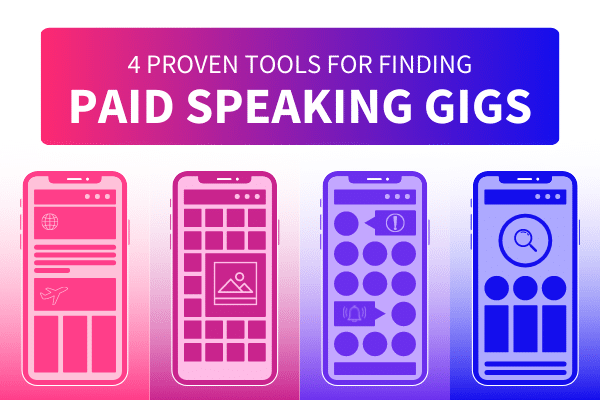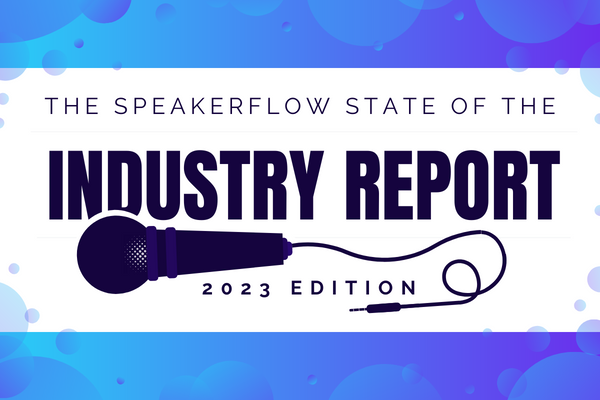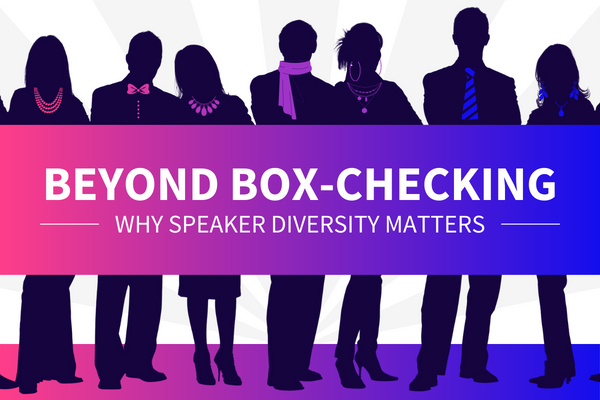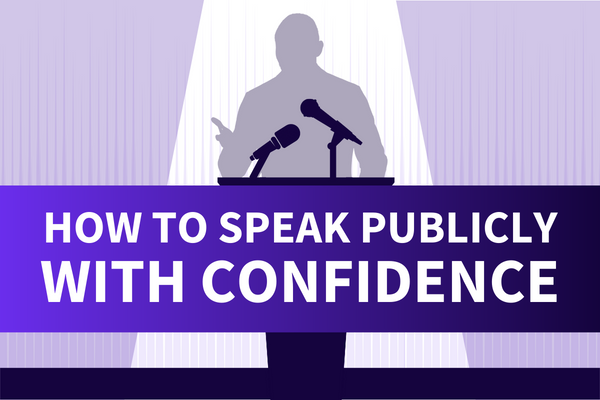Among professional speakers, it’s no secret that finding paid speaking gigs can be difficult. Maybe you’re starting out and unsure where to look. Maybe you’re an established speaker but can’t find reliable lead sources. Or maybe your speaking revenue has plateaued, making it more important than ever that you find new leads and restart that growth.
Even if you’re an experienced speaker, learning how to search for speaking opportunities can be overwhelming if you don’t have a sales background. In fact, many of our clients’ first questions are along the lines of, “How do I find qualified leads efficiently?” and “Which lead sources are exclusive and which are widely accessible?”
With these questions in mind – and regardless of your depth of speaking experience – this guide is intended to make the gig-finding process easier. In the following sections, we’ll break down how to prepare your speaking materials before prospecting and how to plan appropriate pricing options. Additionally, we’ll cover four tried-and-true lead sources you can turn to when you’re next looking for paid speaking gigs. That way, you can spend less time searching and more time in conversation, closing new deals.
Preparing Sales Collateral for Paid Speaking Gigs
Before looking for paid speaking gigs, it’s important to leave time for prep work. In many ways, sales in the speaking industry is like baking, and your ultimate success comes down to the quality of your prep. If you jump into a new recipe without knowing the process or crunched for time, the hours that follow will be rough. But, conversely, if you’ve read the recipe multiple times and pre-measured your ingredients, the baking process will be streamlined and stress-free.
Similarly, finding – and ultimately closing – paid speaking engagements comes down to how much you know ahead of time. If you’re disorganized, prospecting will continue to be a challenge. But, if you know your value, your programs, and your ideal client like the back of your hand, the sale will be a piece of cake (pun intended 😜 ). Plus, the more time you spend prospecting, the better you’ll be able to prepare. Win, win!
Knowing this, the following five items are some of the highest priority components of speaker preparation. Although this isn’t an all-inclusive list, following it will ensure that you go into conversations with new leads (a) confident in your worth and (b) prepared to argue for the greatest possible fee.
Value Proposition
Your value proposition summarizes who you serve, how you serve them, and what benefits your clients see from hiring you. This statement should be clear and concise and should be displayed on your website and in your sales materials. One example on which to base your value proposition is that of Kindra Hall:
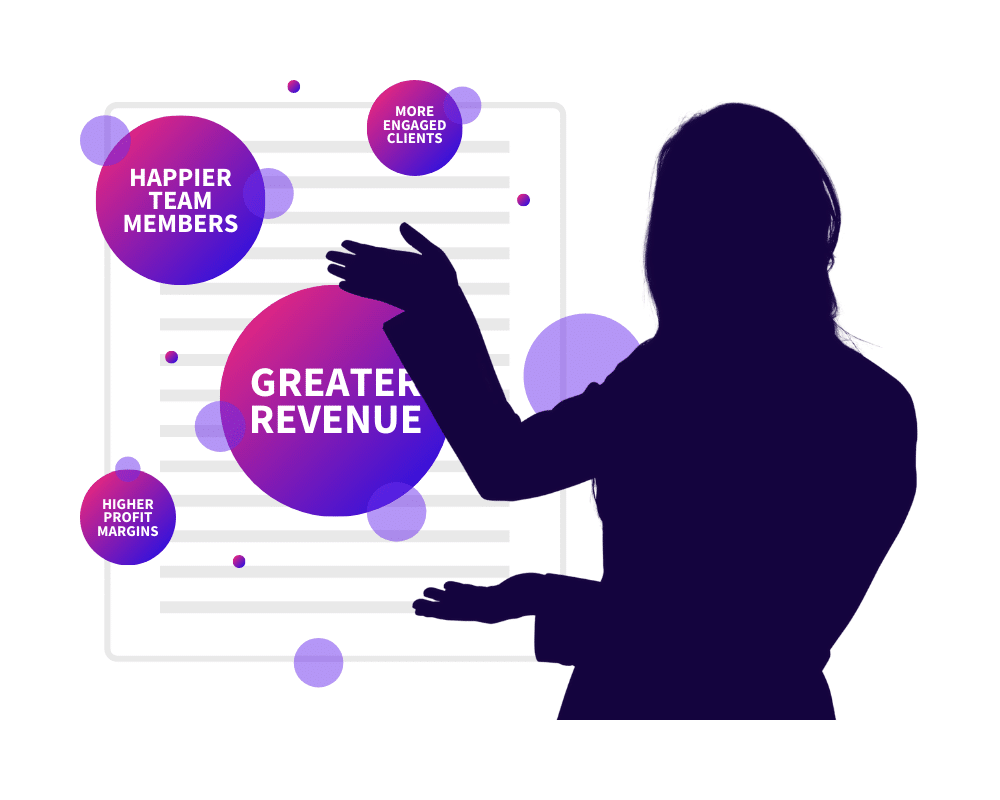
“Kindra Hall helps individuals and companies capture attention, close more sales and blow up their brands through the fine art of strategic storytelling. Each presentation is a meta-learning experience with powerful research, engaging storytelling, and actionable strategies for measurable results.”
Another and equally well-written example is that of Shola Richards:
“Through a transformational roadmap of mindset, behaviors, and tools, Shola helps you to build and sustain compassionate and competent workplace cultures where peak performance, engagement, and satisfaction are the new norm.”
If you haven’t yet written your value proposition – or if you need to update your current one – you can find more information in our previous guide, “5 Key Components Of The Perfect Promise Statement.” 👍
Speaking Program Descriptions
Your speaking program descriptions are short, to-the-point outlines of your “packaged” presentations. These are generally one page when printed or a few paragraphs when online, and should answer the following questions:
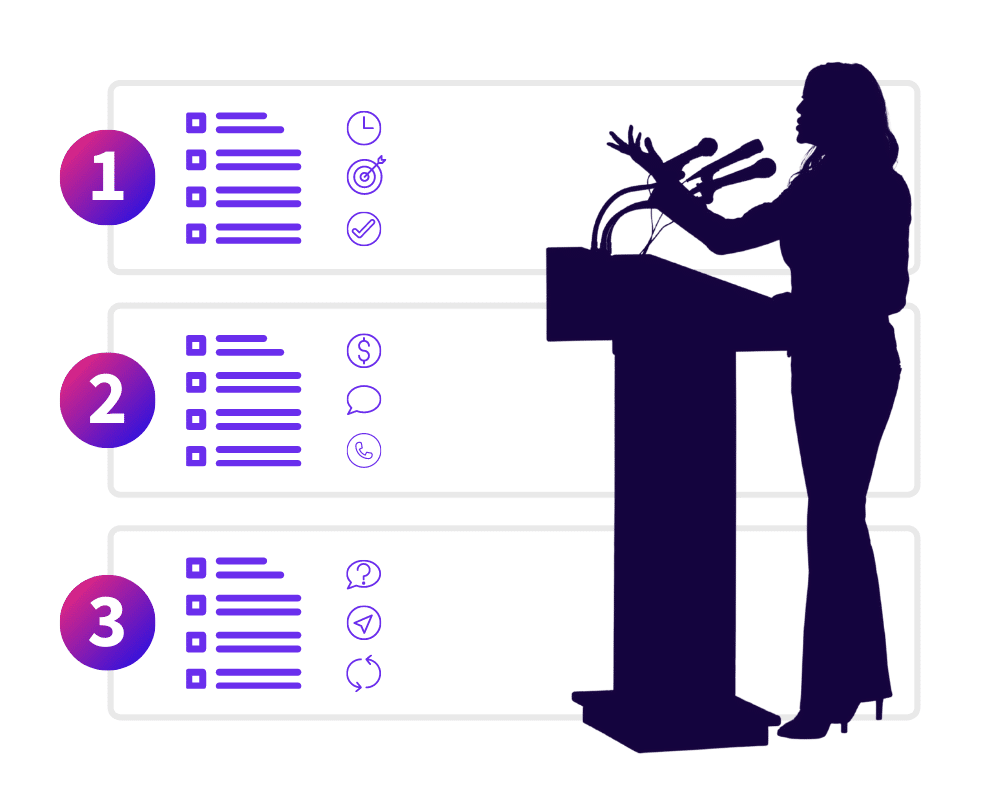
- For which audiences is this program intended?
- What is the primary message or focus of the program? In other words, what challenges or issues does it address, and what solutions does it provide?
- In what formats can clients experience this program (virtual keynote, live keynote, live workshop, etc.)?
- What is the outcome of your program (more engaged teams, better communication, increased sales, etc.)?
- Does this program come with any certifications or credits?
In addition to these questions, each speaking program description should include a testimonial from a previous client. Combined with the informational aspects of the page, this demonstrates the value of the program.
Remember: The goal of program descriptions is to guide the potential client towards the “Proposal” stage of your sales process. Put simply, your first contact should pique their interest. Then, your subsequent conversation and program descriptions should seal the deal. It’s all about leading them to the deal, not pushing them into it.
Testimonials From Previous Clients
Speaking of sealing the deal, your greatest preparation tool is evidence from past clients. According to a 2020 survey, 79% of consumers say they trust online reviews as much as personal recommendations, and, according to a 2017 study, more than 90% are more likely to purchase after reading a trusted review.
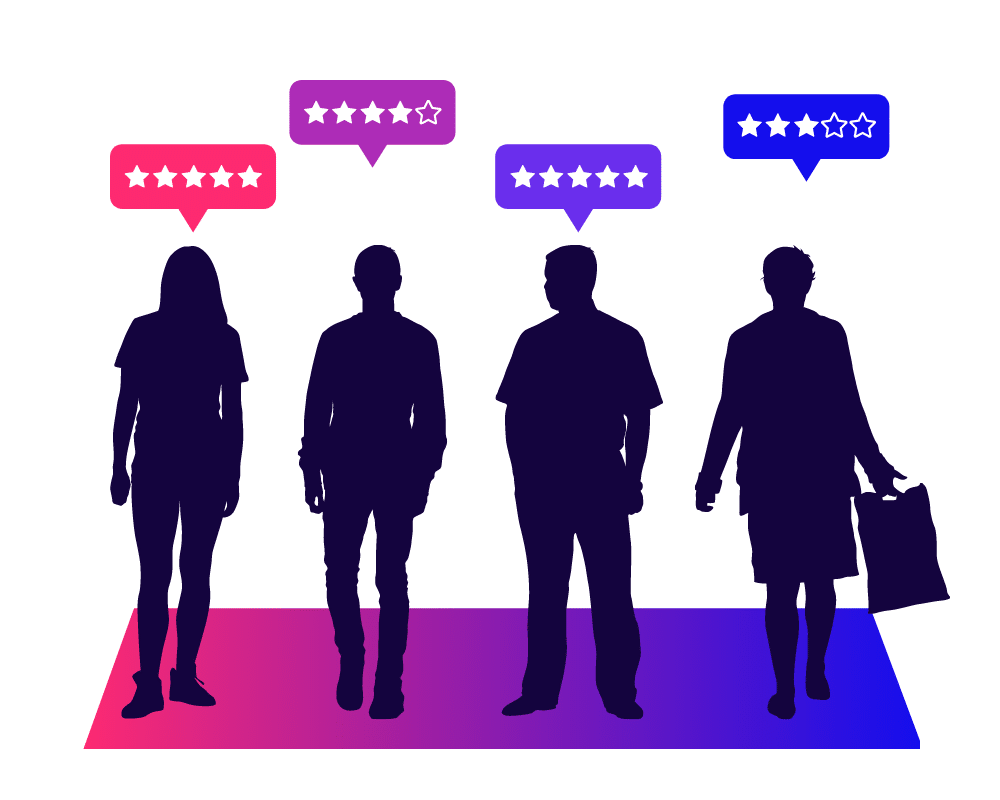
As a speaker, this gives you a chance to close more paid speaking gigs without any exceptional sales strategies or experience. If you aren’t already collecting and sharing reviews, below is your “Getting Started” checklist.
- Ask for a review after every presentation for a new client. Even if it was a quick speech or slide show, it’s always worth asking what you did well, what you can do better, and whether or not they’re willing to put that in writing for your records.
- Ask clients to copy and paste their reviews to a variety of public review channels. Within our team, we usually request that clients share on Google and our Facebook page.
- Keep a running list of your client reviews. It can be a Google or Word document, a section in your CRM – whatever keeps them in one place so they’re easily accessible.
When collecting reviews, remember to also display them consistently. On your speaking program summaries, on your social profiles, on your website, in your speaker kit – everything that a potential client may look at should include reviews.
If you speak for a specific set of industries and have notable clients within those industries, consider creating multiple website pages and versions of your program descriptions. That way, you can send potential clients to a web page that’s written specifically for their industry and features testimonials from their colleagues, making them even more likely to trust and hire you.
Pricing Options
Before any sales conversation, there’s one item to iron out above all else: pricing. For many speakers, the “money conversation” can be intimidating, but one way to prepare ahead of time is to predefine your pricing tiers. These “pre-packaged options” can include a combination of your products or services and should ascend in price.
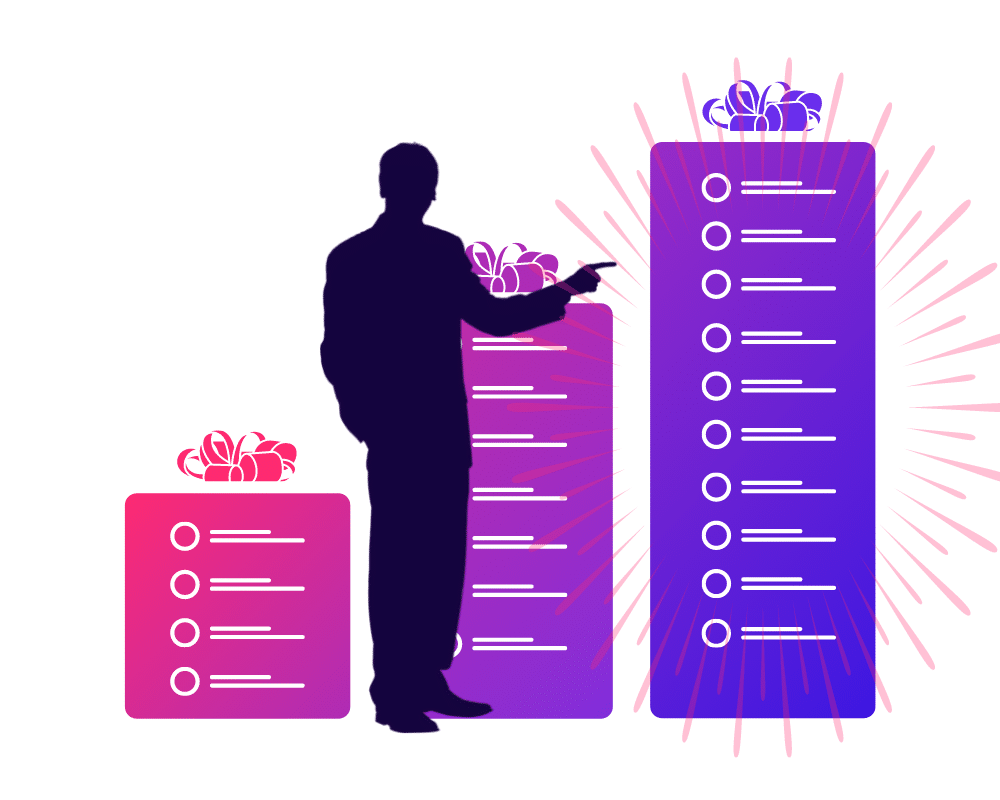
For example, your first package can include a single live keynote with travel to and from the event. Your second package can include the keynote, travel, and copies of your book for everyone in the audience. And, finally, your third package can include a keynote, books, and post-event consulting.
No matter what you include in your pricing packages, the goal is two-fold. On one hand, offering pre-defined packages makes it easier for clients to identify with one in a short period of time. This appeals to time-sensitive, highly organized clients who want to make the decision themselves and know what they need/want.
On the other hand, it also gives you the opportunity to say, “This is the package that I recommend based on the needs and goals you’ve shared with me in our last conversation. Would you agree?”. This appeals to less decisive decision-makers as well as clients who may not be able to articulate which products or services address their problems.
In either case, confirming the price of your paid speaking gigs will not only make you more confident in the money conversation. It will also make it easier for you to stand your ground. After expending time, money, and energy searching for gigs, the last thing you want is to undersell yourself and not earn what you’re truly worth.
Speaker Kit
Lastly, to combine the aforementioned components into a single package, put together a speaker kit! Like a meal kit or a craft project kit, your speaker kit is intended to give potential clients everything they need to know, all in one place. It’s also an easy way for you to demonstrate how easy you are to work with. After all, if you’ve taken the time to organize everything before they hired you, they can only assume you’re going to make things just as convenient after they hire you, too.
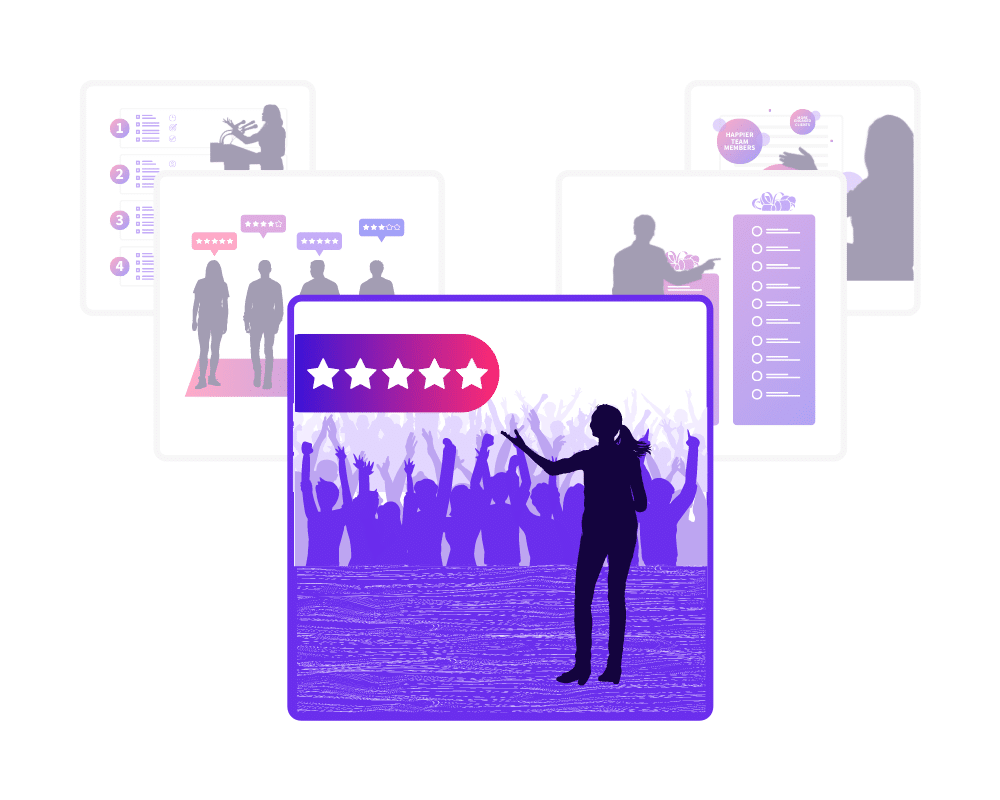
Although the exact contents of speaker kits vary from speaker to speaker, most include:
- A cover page and table of contents
- A brief introductory letter detailing how excited and grateful you are to work with them
- Your biography
- Descriptions of your speaking programs
- Between one and two pages of client testimonials (If you have high-profile clients, a full page of past client logos is a powerful selling point, too.)
- A page listing reasons to work with you (I recommend between five and ten reasons.)
- Your contact information including your email address, phone number, website URL, and social profiles
Once you’ve built your speaker kit, one easy way to build it into your sales process is to add it to your website. At the end of each page, for example, you can add a contact form titled “Request Speaker Kit” or “Request Speaking Information.” Then, when someone submits the form, you can either send them the kit manually or build automation to send it for you. Again, this is an easy way to let potential clients come to you and approach the sale in a non-traditional, less pushy way.
How to Price for Paid Speaking Gigs
On top of your speaking materials, the other major component of your prospecting prep is your fees. As we discussed above, building your fees into distinct pricing tiers can make the final sale decision simpler for you and your potential clients. But what if you don’t know how to charge in the first place? How do you define a baseline fee?
Depending on the speaker in question and the paid speaking gigs they’re after, the appropriate fee range can vary greatly. Non-profit gigs, for instance, will generally pay less than corporate ones. Speakers with more clout in their focus industries can generally charge higher fees. And speakers with sales experience tend to outsell those starting from scratch.
In short, there are countless factors to consider when pinpointing your starting fee. Below are five of the most common things to keep in mind. However, the key is to choose starting prices, test them in sales conversations, and make adjustments until you find the sweet spot. Learn more about pricing for paid speaking gigs in our guide: “How Much Should I Charge As A Speaker?”.
Level of Speaking Experience
The first factor to affect your speaking fees is your depth of experience as a speaker. For the most part, the more experience you have as a speaker, the more credibility you build among event organizers and the more evidence you have for your speaking skills. This allows you to increase your speaking fees as your speaking experience increases.
That said, if you don’t have a great deal of speaking experience or if you’re younger than your competitors, you can work around this factor through public speaking coursework, certifications, or boot camps. When considering your fees, event planners just want to see that your skills warrant the cost. So, ultimately, the number of events you’ve booked – free and paid – matters more than your age.
Level of Experience in Your Focus Industry(ies)
The second factor to affect your speaking fees is your depth of experience as an industry expert. Unlike your speaking experience, your industry credibility is all about the time you’ve spent focused on – and serving – a specific audience. It can be health care, finance, higher education – you name it. But, regardless of your focus, event organizers want to see dedication, that you truly understand their experience and are committed to making it better, not just making a buck for their event. Having seen this, planners are usually willing to pay higher speaking fees.
Nevertheless, just as with speaking experience, there are ways to get around this barrier. For starters, whether you have industry experience or not, start by contributing to industry content channels. The more you’ve shared yourself and the more you’ve contributed to other publishers’ content (blogs, podcasts, etc.), the more authoritative you’ll appear. Again, the idea is to demonstrate your devotion to the industry and everyone in it. That includes the contribution of your time, energy, and money, and there’s no clearer way to do that nowadays than through consistent, shareable digital content.
Products and Services
Third of the factors to affect your fees is your list of products and services. Among speakers, there is a wide range of common sales offerings. Besides the commonplace keynotes and breakout sessions, these include workshops, executive coaching, group coaching, online courses, and workbooks, to name a few.
Depending on your audience, the products and services you offer will vary in depth (in this case meaning how hands-on you have to be) and price. As you might expect, the greater your effort or the more exclusive the product or service, the more you can charge for it.
It’s also important to note that the same rule applies to the level of convenience for your client. If your speaking “package” includes a keynote alone, for example, it’s still largely up to them to make sure the event achieves their goals. But if your package includes a keynote, post-event conference calls with executives, and team-wide consulting, you’ve taken most of that stress and work off of the client’s plate. As a result, you can command a higher fee.
Social Proof
Number four of the fee-limiting factors to keep in mind is your social proof. As mentioned above when we covered the importance of testimonials, social proof is power. Even if you have little speaking or industry experience, having the support and praise of past clients goes a long way to closing future sales. In fact, if you’re approaching a client with whom you have no connections, who knows? Seeing a stellar review – or one from a noteworthy client – may win them over with very little effort on your part.
To capitalize on this effect, there are two main things to keep in mind. First, make a habit of collecting reviews after every event. Sure, not all of them will be all-star clients that leave glowing testimonials, but some of them will. Making it a habit ensures that you don’t accidentally forget to ask the clients that shine on your metaphorical resume.
Second, displaying social proof is key, especially on a variety of sources. If you have a ton of reviews, that’s undoubtedly a win, but they’ll ultimately be useless if no one sees them. If you can highlight testimonials from exceptional clients or – even better – show a long list of positive reviews, you’re sure to boost potential clients’ attention (and their speaking budget) in the process.
Sales Confidence
The final – and most important – factor to affect your speaking fees is your confidence. As any experienced speaker will tell you, a large part of growing your fees is learning to ask for more. If you’re currently asking for $2,500 per keynote, for instance, try asking for $5,000. If you’re asking for $10,000, try asking $12,500. The idea is to build your sales skills not in the traditional sense of “Always Be Closing”. (That usually doesn’t work anymore.)
Instead, as you build your speaking business, work on mastering sales techniques, including the following (i.e. our consultants’ top tips):
- Focus on providing value for the potential client. In every sales call, you shouldn’t come across as understanding, empathetic, and eager to help them meet their goals.
- Be firm but not pushy. Every potential client should feel in control, but this doesn’t mean bending over backward to meet their demands. It just means compromising, so you can help them meet their goals while earning a reasonable return.
- Focus on long-term relationships. If you focus on providing an exceptional experience for your clients, they’ll send you referrals time and time again and come back to you for repeat business. Don’t miss that opportunity!
Ultimately, building confidence in these areas takes time and immeasurable effort. But, once you’ve established your sales skills, I can promise – based on my experience and that of our clients – it will inevitably pay off, both monetarily and in future negotiations.
For more sales tips, check out our podcast, Technically Speaking. Every week, we host a different guest from the world of thought leadership. So, if you’re starting from scratch in the sales department, you can rest assured you’re not alone and learn from their experience. 👌
Tools for Finding Paid Speaking Gigs
At this point, now that we’ve covered all of the prep work “bases” of finding paid speaking gigs, it’s time to dive into the tools. Currently, the number of technological options available to speakers is relatively limited. Additionally, many of the tools that do exist – such as D&B Hoovers or Data Axel Genie – are not only shared with countless other users but also (a) not tailored to the speaking market and (b) infrequently updated. Unsurprisingly, this adds to many speakers’ frustrations when it comes to finding gigs.
If you’re in this boat and looking for better, more reliable ways to find paid speaking gigs, the following four options are for you. Although this isn’t an exhaustive list – I’ll cover that in a later guide – they are tried and tested by countless other speakers. That way, whether you’re a new speaker or an experienced one, a solopreneur, or the owner of a large speaking business team, you can trust that at least one of these lead sources will work for you, too.
Industry Publications & Content Sources
The first place in which to find paid speaking gigs is your focus industries, specifically their most prevalent content channels. Looking at any industry – from higher education to music – there are countless places to find information. Within the speaking industry itself, for example, some of the most well-known sources of information are the Speaker Lab Podcast and speaking association events.
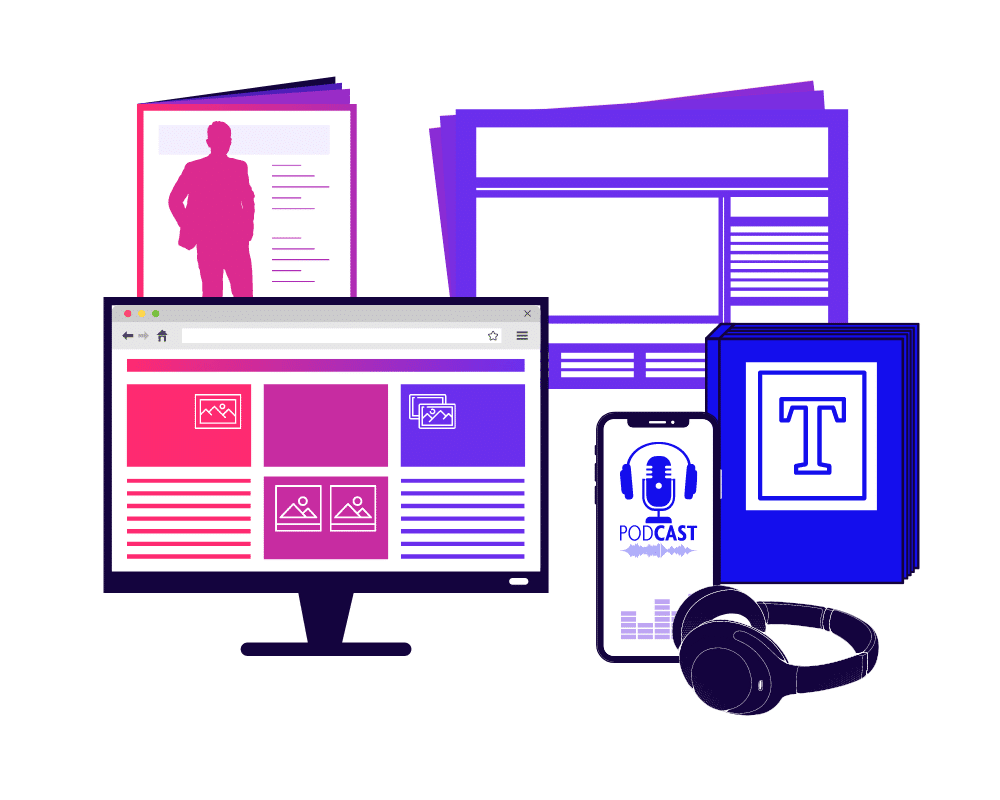
As a speaker, your job is to find similarly reliable sources of information in your area of focus. From there, you have two options for finding paid gigs. First, connect with existing experts working on those content sources to contribute your own insights. You’re not merely a speaker – you’re an expert. So, the more you can contribute to authoritative content sources in your industry(ies), the better you’ll be able to position yourself as an expert, and the more industry event organizers will look to you for their events. In other words, rather than approaching them, they’ll be approaching you, hoping your calendar is open for their event.
The second way to find paid gigs is to consider events advertised in industry publications. For instance, when an industry magazine promotes an annual conference, add it to your list of potential leads. Then, find out whether or not they’ve already hired their speakers. If they haven’t, conduct your sales process as you normally would, pitching your speaking services. If they have chosen their speakers for this year, set a reminder in your customer relationship management system so you can reach out before next year’s conference. Even if you missed this gig, building your reputation – and preparing ahead of time – will almost always give you a leg-up the next time around.
eSpeakers Marketplace
Second on our list of lead sources is eSpeakers Marketplace. Established in 1999, eSpeakers has long been a reliable source of information for event organizers, as the Marketplace area of the site allows them to research multiple speakers from a single, convenient platform.
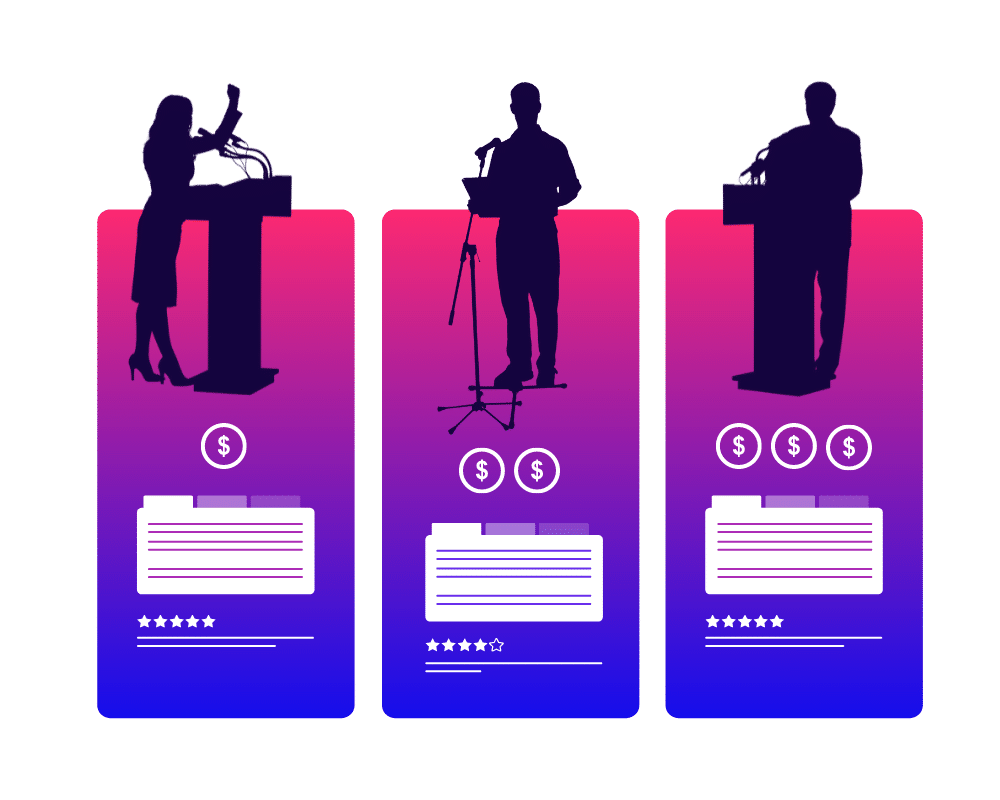
However, from a speaker’s perspective, eSpeakers Marketplace also gives you the opportunity to learn from your competitors. If you’re a sales speaker, for example, you can find other sales speakers in their list, and look over their customer reviews. Considering you both focus on the same topic, chances are that their past clients are a good fit for your programs, too. They just don’t know it yet!
To make the most of this opportunity, follow the steps below:
- Navigate to eSpeakers Marketplace and click “Browse Local Speakers.”
- On the page that opens, enter at least one keyword or phrase into the “Name, topic, keyword” box. Then, hit “Enter” on your keyboard.
- You’ll see a “Searching…” message for a moment. Once that fades, you’ll see a list of speakers that focus on the aforementioned topic. Click on one to begin.
- On the individual speaker’s page, click on the “Reviews” tab. Here, you’ll find the contact and company names of their past clients, which you can then use in your own prospecting efforts. We recommend saying something like, “I saw that [speaker name] spoke for you in the past. Since we have complementary programs, I thought it was worth reaching out to see if I could help you and your team build on their insights.”
Essentially, using eSpeakers Marketplace to look for paid speaking gigs is about competitor research. From speaking opportunities to speaking materials, all you have to do is look at their profiles to piggyback on their past sales.
Your Customer Relationship Management System
Number three of our lead sources is a simple one: your list of previous clients. For the most part, this blog has focused on the “original sale” with an event organizer. But, beyond that point, your existing client list is also a stellar source of leads for upselling and cross-selling.
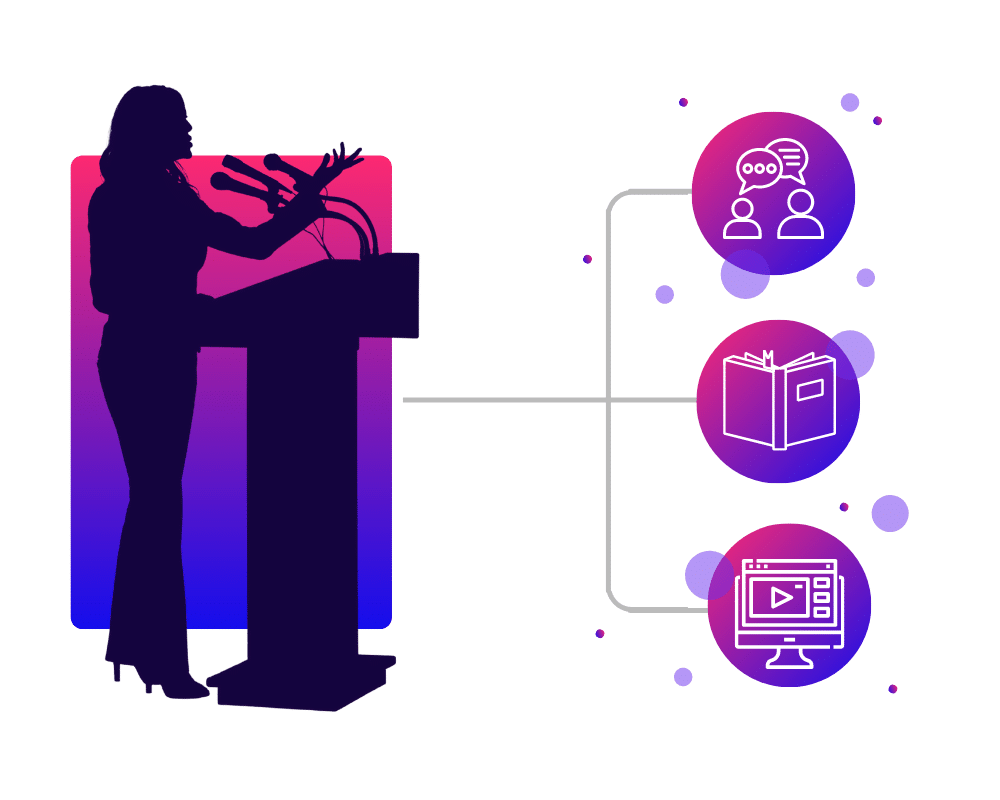
The former of these, upselling, is exactly as the name suggests: a method of bringing past clients into more lucrative deals. A past keynote client, for example, may also be a good fit for company-wide consulting. A past consulting client may be suited to group coaching. You may even have instances in which multiple products and services are appropriate. Whatever you offered in the original contract, upselling is about building on that product or service to further your positive impact with that client. It’s also about continuing your relationship with that client so you can not only earn from your direct work with them but also from their referrals later on.
Similarly, the second sales option for previous clients – cross-selling – is about transitioning your relationship into a new offering. Unlike upselling, cross-selling isn’t about making more money than in your previous deal. Instead, it’s about continuing your work with that client for a similar price point. The aforementioned keynote client, for instance, could hire you for a breakout session, and the consulting client could use executive coaching.
Summarily, with both upselling and cross-selling, the goal is to further your partnership in a way that benefits everyone. That way, the client continues to profit from your expertise, and you can continue building the relationship without being underpaid.
Speaker Intel Engine
Finally, the fourth lead source – and one that combines the aforementioned strategies – is the Speaker Intel Engine. Developed by speaker and sales expert Sam Richter, the Intel Engine is a Google Search overlay that simplifies the gig-searching process while simultaneously allowing the user to access 100% of Google’s search results (rather than the standard 4%).
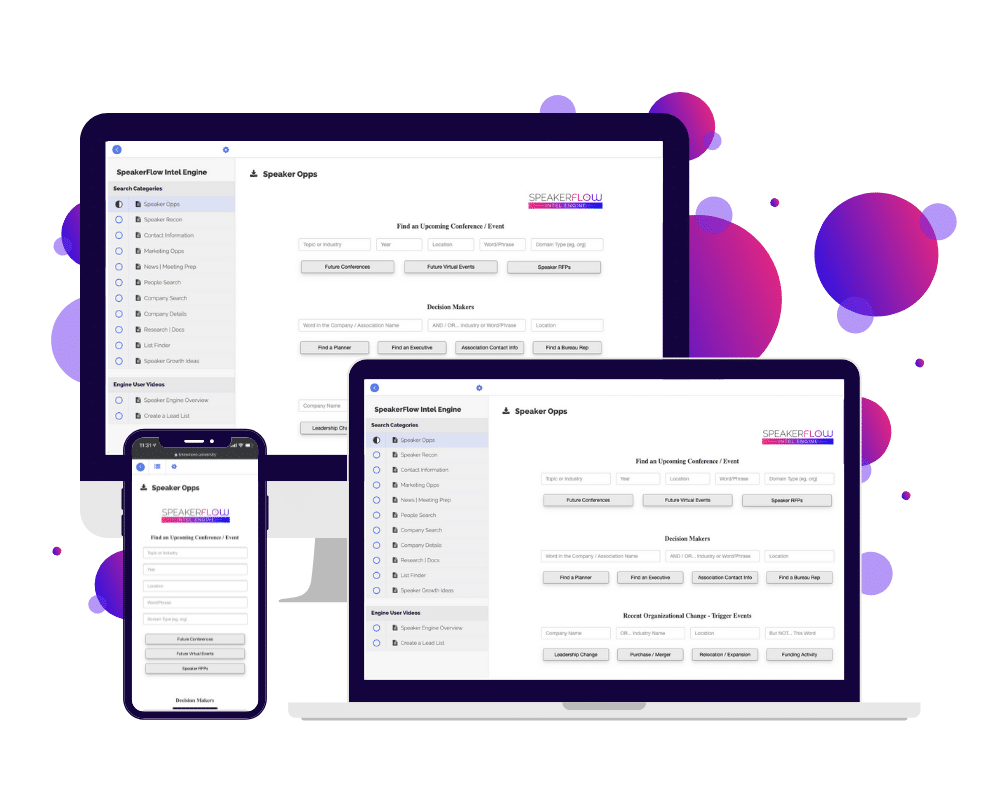
Unlike the other methods for finding paid speaking gigs, the Intel Engine facilitates a wide range of actions through a single portal and for a single fee, including:
- Find conferences that hire speakers in any industry, anywhere
- Find meeting planners, bureau reps, and executives in any industry, anywhere
- Locate “Call for Speakers” and find out who needs you for an upcoming conference
- Find contact information on your prospects, including email addresses and LinkedIn profiles
- Research other speakers and learn where they got paid to speak
These are just a few of the many ways to use the Intel Engine. Ultimately, combining these strategies means more information about more qualified leads, all in less time than you would spend on the previous three gig-finding strategies. What’s not to love about that, right? 🙌
Hopefully, with this guide in hand, your next round of prospecting will not only be more productive but also less stressful, so you can spend less time worrying and more time winning new clients.
For the time being, for more information about finding paid speaking gigs, check out our previous guide, “How To Get Speaking Gigs: The Ultimate Guide.”
